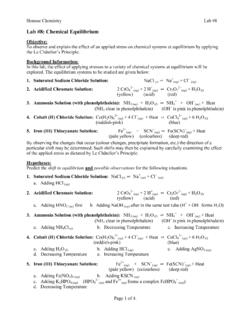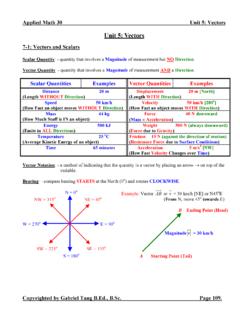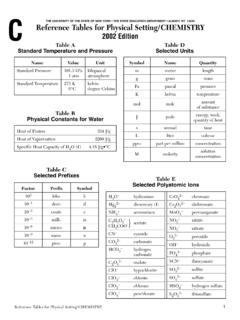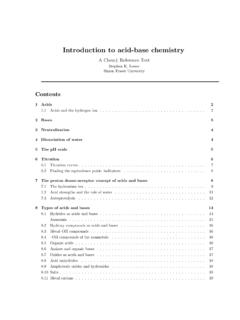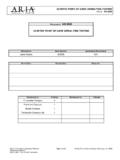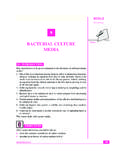Transcription of Lab 09 Weak Acid and Strong Base Titration - doctortang.com
1 Honour Chemistry Lab #9. Lab #9: Weak < strong >acidstrong > and < strong >Strongstrong > < strong >basestrong > < strong >Titrationstrong > Objectives: 1. To accurately determine the mass content of acetylsalicylic < strong >acidstrong > in an Aspirin tablet a common analgesic (painkiller) medicine by titrating it with a < strong >Strongstrong > < strong >basestrong > . 2. To sketch the < strong >Titrationstrong > curve of acetylsalicylic < strong >acidstrong > by titrating it with a < strong >Strongstrong > < strong >basestrong > and determine its Ka. Background Information: History of Aspirin (taken from Wikipedia). The Bayer Company of Germany coined the brand name Aspirin. In some countries the name is used as a generic term for the drug rather than the manufacturer's trademark. In countries in which Aspirin remains a trademark, the initial ASA (for acetylsalicylic < strong >acidstrong > ) is used as a generic term. The name "aspirin" is composed of a- (from the acetyl group) -spir- (from the plant genus Spiraea) and -in (a common ending for drugs at the time).
2 It has also been stated that the name originated by another means. "As-" referring to AcetylSalicylic and "-pir-" in reference to one of the scientists who was able to isolate it in crystalline form, Raffaele Piria. Finally, "-in", because it was a common ending for drugs at the time. On March 6, 1899, Bayer registered it as a trademark. However, the German company lost the right to use the trademark in many countries because the Allies seized and resold its foreign assets after World War I. The right to use "Aspirin" in the United States (along with all other Bayer trademarks) was purchased from the government by Sterling Drug in 1918. Even before the patent for the drug expired in 1917, Bayer had been unable to stop competitors from copying the formula and using the name elsewhere, so, with a flooded market, the public was unable to recognize "Aspirin" as coming from only one manufacturer.
3 Sterling was subsequently unable to prevent "Aspirin" from being ruled a generic trademark in a federal court in 1921. Bayer ultimately acquired Sterling in 1994, but this did not restore the trademark. Other countries (such as Canada and many countries in Europe) still consider "Aspirin" a protected trademark. Hippocrates, a Greek physician, wrote in the 5th century BC about a bitter powder extracted from willow bark that could ease aches and pains and reduce fevers. This remedy is also mentioned in texts from ancient Sumer, Lebanon, and Assyria. The Cherokee and other Native Americans used an infusion of the bark for fever and other medicinal purposes for centuries. The medicinal part of the plant is the inner bark and was used as a pain reliever for a variety of ailments.
4 The Reverend Edward Stone, a vicar from Chipping Norton, Oxfordshire, England, noted in 1763 that the bark of the willow was effective in reducing a fever. The active extract of the bark, called salicin, after the Latin name for the white willow (Salix alba), was isolated to its crystalline form in 1828 by Henri Leroux, a French pharmacist, and Raffaele Piria, an Italian chemist. Piria was able to convert the substance into a sugar and a second component, which on oxidation becomes salicylic < strong >acidstrong > . Salicylic < strong >acidstrong > was also isolated from the herb meadowsweet (Filipendula ulmaria, formerly classified as Spiraea ulmaria) by German researchers in 1839. While their extract was somewhat effective, it also caused digestive problems such as gastric irritation and bleeding and diarrhea, and even death when consumed in high doses.
5 In 1853, a French chemist named Charles Frederic Gerhardt neutralized salicylic < strong >acidstrong > by buffering it with sodium (sodium salicylate) and acetyl chloride, creating acetosalicylic anhydride. Gerhardt's product worked, but he had no desire to market it and abandoned his discovery. In 1897, researcher Arthur Eichengr n and Felix Hoffmann, a research assistant at Friedrich Bayer & Co. in Germany, derived one of the hydroxyl functional groups in salicylic < strong >acidstrong > with an acetyl group (forming acetylsalicylic < strong >acidstrong > , an acetyl ester). This thereby greatly reduced the negative effects caused by the free phenolic group of salicylic < strong >acidstrong > . When in the body, the ester (aspirin) is hydrolyzed to free the active drug. This was the first synthetic drug, not a copy of something that existed in nature, and the start of the pharmaceuticals industry.
6 Hoffmann made some of the formula and gave it to his father, who was suffering from the pain of arthritis and could not stand the side effects of salicylic < strong >acidstrong > . With good results, he then convinced Bayer to market the new wonder drug. 'Aspirin'. was patented on March 6, 1899. It was marketed alongside another of Hoffmann's products, an acetylated synthetic of morphine called 'Heroin' that he invented 11 days after aspirin. Heroin was initially the more successful of the two painkillers and it was common belief that it was healthier than aspirin. But, as heroin's shortcoming of addictiveness became more obvious, aspirin stepped to the forefront. Aspirin was originally sold as a powder (still the preferred form in many European countries) and was an instant success; in 1915, Bayer introduced aspirin tablets.
7 Page 1 of 4. Honour Chemistry Lab #9. Aspirin as a Weak < strong >acidstrong > Aspirin is a weak < strong >acidstrong > with a Ka = 10 4. The chemical structures of the < strong >acidstrong > and its conjugate < strong >basestrong > are as follow. In this lab, we will use the short form HASA for acetylsalicylic < strong >acidstrong > and ASA for the acetylsalicylate. _. O O. C H C. O O. O O. C C CH3. CH3. O. O. Aspirin - Acetylsalicylic < strong >acidstrong > (HASA) Acetylsalicylate ion (ASA ). Indicators Phenolphthalein and the Universal Indictor Solution will be used in this lab. The Universal Indicator Solution has the following colours at various pH ranges. pH Colour pH Colour 3 red-orange 7 green 4 orange 8 blue-green 5 yellow 9 blue-gray 6 greenish-yellow 10 violet Materials: Ring Stand Buret Funnel and Buret Clamp NaOH (aq) ( M). pH meter 3 Small / Medium Erlenmeyer Flasks 3 to 4 Aspirin Tablets (aq) (325 mg each).
8 Stirring Rod Mortar and Pestle Phenolphthalein Buret Electronic Balance Universal Indicator Solution Graduated Cylinder 1 Small Beaker and 1 Medium Beaker Ethanol Hypothesis / Pre-lab Exercise: 1. Write the balanced molecular equation for the neutralization of HASA (aq) with NaOH (aq). 2. Given that each Aspirin tablet is 325 mg, calculate the volume of M of NaOH (aq) required to completely neutralize the tablet. 3. Determine the both endpoint colours of phenolphthalein and universal indicator appropriate for this experiment (from reading the procedure below and the background information above). Procedure: Part A: < strong >Titrationstrong > of Aspirin with NaOH using Phenolphthalein 1. Coat the buret with the NaOH (aq) at least twice and discard the wash fluid. 2.
9 Set up the < strong >Titrationstrong > apparatus with the ring stand, buret clamp, buret and buret funnel. 3. Fill the buret with NaOH (aq) using the buret funnel. Be sure not to pass the 0 mL mark. 4. Record the starting volume of the NaOH (aq). 5. Measure and record the mass of an aspirin tablet. 6. Label a medium beaker as ethanol. Obtain approximately 100 mL of ethanol from your instructor. 7. Grind the aspirin tablet into powder using mortar and pestle. Pour about 10 mL of ethanol into the mortar to dissolve the powder (not all the powder will dissolve). Using a stirring rod as a guide, transfer the content into an Erlenmeyer flask. Repeat until all the powder from the mortar is transferred into the flask. (Alternatively, place the tablet directly into an Erlenmeyer flask.)
10 Add about 20 mL of ethanol into the flask. Using the stirring rod, break the tablet apart and dissolve it as much as possible into the ethanol solvent. Wash the stirring rod with a small amount of ethanol when finished.). Page 2 of 4. Honour Chemistry Lab #9. 8. Add a few drops of phenolphthalein in the flask. 9. Begin < strong >Titrationstrong > of the aspirin. Swirl the Erlenmeyer flask when adding the NaOH (aq). Depending on the amount of ethanol used as the initial solvent for the aspirin tablet, the equivalence point is around pH Stop the < strong >Titrationstrong > when the endpoint is reached. Record the final volume of the NaOH (aq). Calculate the net volume of < strong >basestrong > added. 10. Repeat the < strong >Titrationstrong > with the other two Erlenmeyer flasks. Be sure to record the initial and final volume of the buret each time.




